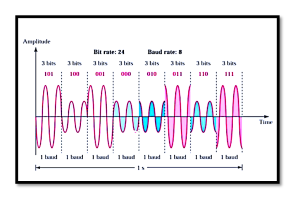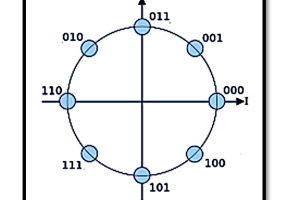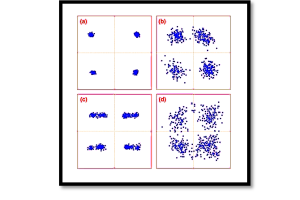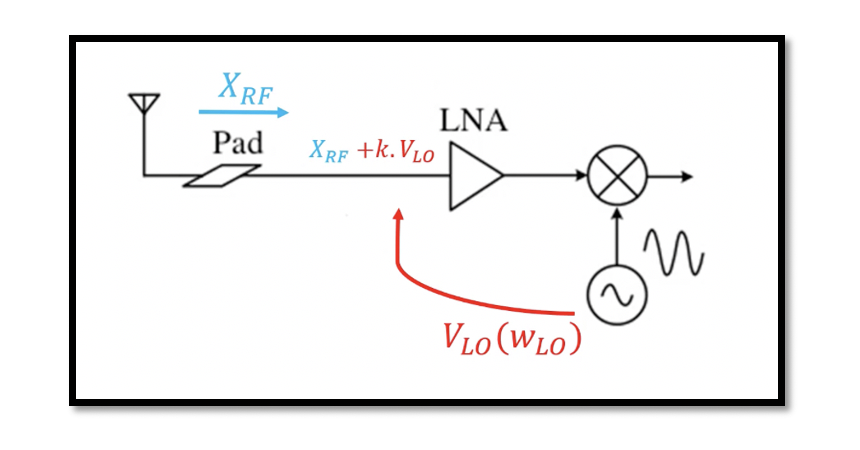
Drawbacks of Direct Conversion Receivers (Homodyne Receivers)
What is a Homodyne Receiver?
In a receiver the frequency of a signal is shifted by multiplying with another sinusoidal signal called the carrier wave. This multiplication is performed by a mixer and the sinusoidal wave is generated by the local oscillator. The low pass filter after the mixer removes the high frequency signal leaving only the lower frequencies. Receivers down converts the Radio Frequency to Intermediate Frequency. First the receiver down converts from RF to IF1 and then to IF2 which is then changed to zero IF as discussed in the previous sections. If a receiver down converts RF directly to zero IF without having any steps between then that type of receiver is called direct conversion receivers. The direct conversion receivers are also called the homodyne receivers. The down conversion has only one step in this receiver type, from RF to zero IF.
Homodyne receivers are signal stage frequency converter, uses the carrier as transmitter to down convert our signal translating the spectrum to DC. We already discussed some advantage of direct conversion receivers in the section Introduction to direct conversion receivers:
Advantages of homodyne receivers
- It has a simple design, hence reduces the system complexity.
- There is no image problem due to one step conversion.
- The channel selection is done by low pass filters. Low pass filters are on-chip and are active filters.
- It is simple to handle as the mixing spurs are significantly reduced in number.
- High-selectivity.
Disadvantages of homodyne receivers
The first drawback of direct conversion receiver is DC offset.
DC offset is coming from local oscillator leakage. The local oscillator leakage problem causes large DC offset in the base band and saturates the baseband circuits.
There is a voltage in the local oscillator and it somehow it finds its way to the input of LNA and the path is through the mixer from output of LNA to the input of LNA because of the poor isolation. Even if there is isolation we will have some leakage, as it is not possible to eliminate completely.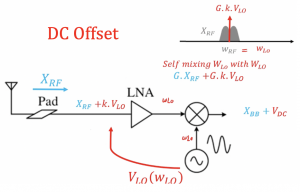
The RF signal is combined with the local oscillator voltage with coefficient k, it means that the voltage doesn’t have same amplitude as it paths through different ways, however, the frequency (wLO) remains the same.
At the output of LNA the RF signal is amplified, where G is the gain of LNA, the leaked voltage also get amplified with gain G. As we know that in zero IF wLO will be equal to wRF. Therefore, the output of LNA is wLO same as the voltage of local oscillator so, wLO – wLO =0 hence we have DC value XBB+VDC. This is the result of self mixing as you can see the VLO comes to the input of LNA it goes to the output and has the same frequency, so when we mix this together we will have DC value along with our channel.
Example question to calculate DC offset for homodyne receiver:
LO leakage at the output of LNA is -60dBm. Offset at the output of mixer and baseband chain.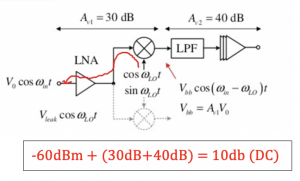
Let’s assume the leakage is from cos wLOt, it will pass through mixer and then LNA and it is -60dBm at the input of LNA. If you find the peak-to-peak voltage here its around 600mV which is not really high. When it goes to output of LNA and it will be mixed by cos wLOt, it has frequency of wLO and produce DC offset here and also it will be amplified.
So, -60dBm + (30dB+40dB) = 10db (DC) and the voltage value will be V=1v. It will saturate the IF amplifier operation point.


